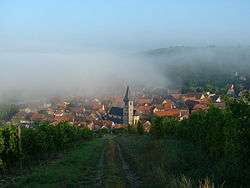Randersacker
| Randersacker | ||
|---|---|---|
|
Randersacker on a foggy summer morning | ||
| ||
 Randersacker | ||
Location of Randersacker within Würzburg district  | ||
| Coordinates: 49°45′32″N 09°58′58″E / 49.75889°N 9.98278°ECoordinates: 49°45′32″N 09°58′58″E / 49.75889°N 9.98278°E | ||
| Country | Germany | |
| State | Bavaria | |
| Admin. region | Unterfranken | |
| District | Würzburg | |
| Government | ||
| • Erster Bürgermeister | Dietmar Vogel (UWG) | |
| Area | ||
| • Total | 16.20 km2 (6.25 sq mi) | |
| Population (2015-12-31)[1] | ||
| • Total | 3,403 | |
| • Density | 210/km2 (540/sq mi) | |
| Time zone | CET/CEST (UTC+1/+2) | |
| Postal codes | 97236 | |
| Dialling codes | 0931 | |
| Vehicle registration | WÜ | |
| Website | www.randersacker.de | |
Randersacker is a municipality in the district Lower Franconia part of Bavaria. With its long tradition in wine making, Randersacker belongs to the most well-known wine places of Germany. It is a suburb of Würzburg, the capital of Lower Franconia and adjoins to Würzburg boroughs Heidingsfeld, Rottenbauer, Sanderau and Frauenland and to the municipalities of Gerbrunn, Theilheim and Eibelstadt.
Geography
Randersacker is located in the south of Würzburg. This part of the Main is called Maindreieck. This term refers to the course of the river, it looks similar to a triangle. The city of Würzburg is about three miles away from the village center of Randersacker.
There are two subdistricts: Lindelbach and the mainpart Randersacker.
Geology
The ground of Randersacker consists of shellbearing limestone. To the middle of the 20th century the region was a centre of the quarry industry. There are still residues on top of some hills. An important historic monument is the museum-quarry near Lindelbach[2] with a well conserved crane.
History
The first written mention of a settlement on the location of Randersacker was in 779. It was the Würzburger Markbeschreibung (report of Würzburg area). It reports that there were some vineyards on this ground.
The first mention of Randersacker was in 1123.
Population
1970 3.378
1987 3.507
2000 3.513
2009 3.435
Economy
The most important industries in Randersacker are Viticulture and Tourism. There are about 17 winemakers and several restaurants and hotels.
Traffic
The well known Autobahn A3 passes Randersacker 2 kilometres south of the village centre. Also the river Main is a transport route of national importance.
Main sights
This Balthasar Neumann Pavilion is a pavilion designed and built by the famous architect Johann Neumann about 1750. It is the smallest building of Balthasar Neumann and is entirely conservated. Today the pavilion serves for representation purposes e.g. weddings.
The Church Sankt Stephanus is one of the most beautiful romanesque churches in Franconia. The steeple is about 30 metres (98 ft) high and was built in the 13th and 14th centuries.
The Zehnthof is an old manor in Randersacker.

